Erastus Salisbury Field

Erastus Salisbury Field (May 19, 1805 in Leverett, Massachusetts – June 28, 1900 in Sunderland, Massachusetts) was an American folk art painter of portraits, landscapes, and history pictures.
Erastus Field and his twin sister, Salome, were born in Leverett, Massachusetts, on May 19, 1805. By the age of nineteen, Field had displayed sufficient talent in sketching portraits to be admitted as a student at the studio of Samuel F. B. Morse in New York. Morse closed his studio some three months later, and Field returned to Leverett in 1825.[1][2] His earliest known painting is a portrait of his grandmother, Elizabeth Billings Ashley, painted around 1826.[3]
Field married Phebe Gilmur in Ware, Massachusetts, in 1831. They had one daughter, born in 1832. Field made a good living as a limner or itinerant portrait painter in the 1830s, traveling in western Massachusetts and the Connecticut Valley. He was known for his ability to capture "a good likeness" in a single sitting.[2][4] In the 1840s, the family settled in Greenwich Village in New York City, where Field exhibited a few paintings and is thought to have taken up the new art of photography. He learned from David Acheson Woodward to use the latter's 1857 solar camera to make enlargements from collodion negatives of portraits onto photo-sensitized canvas which he would over-paint in oils.[5]
He remained in New York for about seven years before relocating to Sunderland, Massachusetts to manage his ailing father's farm. From about 1847 Field embarked on a new phase of his artistic career, creating landscapes and history paintings, as photography began to supplant painting as the preferred medium for portraiture.[1][2]
Following the death of his wife in 1859, Field and his daughter moved to the settlement of Plumtrees in Sunderland, where he built a studio and continued to paint biblical scenes and Romantic landscapes. From the end of the Civil War he painted mostly historical and patriotic works. His best-known work, the Historical Monument of the American Republic, is a fantastical architectural image of key aspects of American history, inspired by plans for the Centennial Exposition to be held in 1876. Field began work on the large canvas in 1867 and was still adding to it as late as 1888.[3]
Field died at Plumtrees, Sunderland, on June 28, 1900.[1][2]
All together, over 300 surviving works are attributed to Field.[2]
Works
Portraits
-
 Elizabeth Billings Ashley, ca. 1826
Elizabeth Billings Ashley, ca. 1826 -
![Portrait of a Young Woman, ca. 1830[4]](//upload.wikimedia.org/wikipedia/commons/thumb/a/ae/Erastus_Salisbury_Field_Portrait_of_a_Young_Woman.jpg/239px-Erastus_Salisbury_Field_Portrait_of_a_Young_Woman.jpg) Portrait of a Young Woman, ca. 1830[4]
Portrait of a Young Woman, ca. 1830[4] -
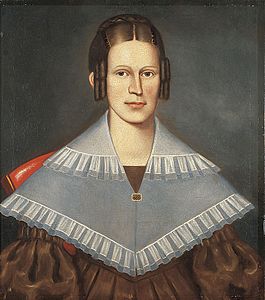 Portrait of Thankful Field (the artist's sister-in-law), 1835
Portrait of Thankful Field (the artist's sister-in-law), 1835 -
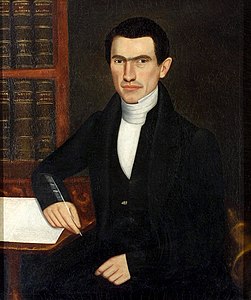 Josiah Goddard, 1838
Josiah Goddard, 1838 -
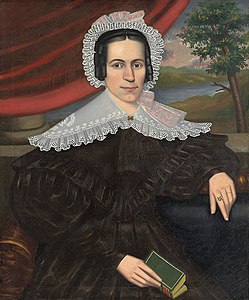 Woman with a Green Book (Louisa Gallond Cook?), ca. 1838
Woman with a Green Book (Louisa Gallond Cook?), ca. 1838 -
 Josiah B. Woods Jr., ca. 1838, Princeton University Art Museum
Josiah B. Woods Jr., ca. 1838, Princeton University Art Museum -
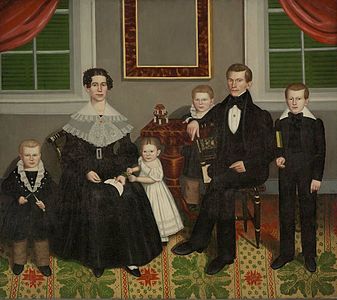 Joseph Moore and His Family, ca. 1839
Joseph Moore and His Family, ca. 1839 -
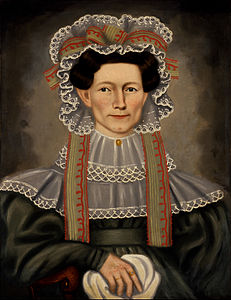 Lady of Squire Williams House ca. 1829
Lady of Squire Williams House ca. 1829
Later works
-
 The Garden of Eden, ca. 1860
The Garden of Eden, ca. 1860 -
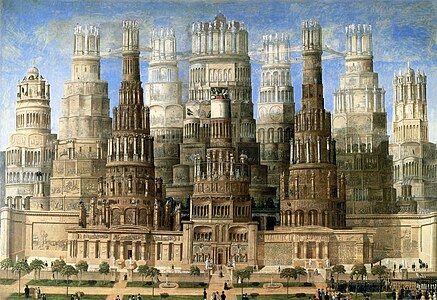 Historical Monument of the American Republic, 1867–1888
Historical Monument of the American Republic, 1867–1888 -
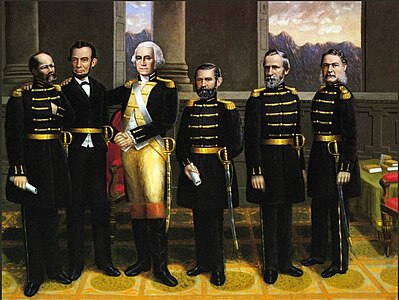 Lincoln with Washington and his Generals, 1881
Lincoln with Washington and his Generals, 1881
References
| External videos | |
|---|---|
 | |
 Smarthistory – Erastus Salisbury Field's Portrait of a Young Woman[4] Smarthistory – Erastus Salisbury Field's Portrait of a Young Woman[4] |
Notes
- ^ a b c Maytham (1963), pp. 31–33
- ^ a b c d e "National Gallery of Art:Erastus Salisbury Field". Archived from the original on 11 November 2010. Retrieved 4 January 2013.
- ^ a b "Erastus Salisbury Field". The Concise Grove Dictionary of Art. Oxford University Press. 2002. Retrieved 6 January 2013.
- ^ a b c "Erastus Salisbury Field's Portrait of a Young Woman". Smarthistory at Khan Academy. Retrieved January 4, 2013.
- ^ Hannavy, John (2013-12-16). Hannavy, John (ed.). Encyclopedia of Nineteenth-Century Photography. doi:10.4324/9780203941782. ISBN 9780203941782.
Bibliography
- Maytham, Thomas N. (1963). "Two Faces of New England Portrait Painting: Erastus Field and Henry Darby". Bulletin of the Museum of Fine Arts. 61 (323). Museum of Fine Arts, Boston: 30–43. JSTOR 4171376.
External links

- Works by Erastus Salisbury Field at the National Gallery of Art
- 19th Century American Women by Erastus Salisbury Field

![Portrait of a Young Woman, ca. 1830[4]](http://upload.wikimedia.org/wikipedia/commons/thumb/a/ae/Erastus_Salisbury_Field_Portrait_of_a_Young_Woman.jpg/239px-Erastus_Salisbury_Field_Portrait_of_a_Young_Woman.jpg)



















